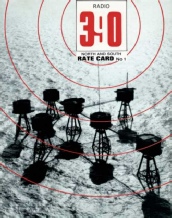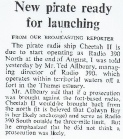© 2014-


Radio 390 - History (2)
1966
Radio 390 had e xpansionist plans during the spring and summer of 1966. During May 1966 negotiations were opened with Mrs. Britt Wadner, owner of the former Scandinavian station Radio Syd, to purchase her radio ship, Cheeta 2, which was lying at anchor off Harwich having fulfilled her role as a temporary home for Radio Caroline South. Although others, notably Radio London, had looked at the possibility of purchasing Cheeta 2 nothing had ever been concluded and because of tougher laws passed in Sweden at the beginning of 1966 there was now no possibility that Radio Syd could ever return to the air from its former anchorage off Malmo.
xpansionist plans during the spring and summer of 1966. During May 1966 negotiations were opened with Mrs. Britt Wadner, owner of the former Scandinavian station Radio Syd, to purchase her radio ship, Cheeta 2, which was lying at anchor off Harwich having fulfilled her role as a temporary home for Radio Caroline South. Although others, notably Radio London, had looked at the possibility of purchasing Cheeta 2 nothing had ever been concluded and because of tougher laws passed in Sweden at the beginning of 1966 there was now no possibility that Radio Syd could ever return to the air from its former anchorage off Malmo.
The plan was to anchor the Cheeta 2 off the coast of either North Wales or the Wirral peninsular in the north west of England to broadcast 'sweet music' programmes under the call sign Radio 390 North. With the original station on Red Sands Fort renamed Radio 390 South, this would have given listeners and advertisers an easy listening station with almost national coverage and an alternative to Radio Caroline's national pop music service.
The station also made plans to introduce a VHF (FM) service in the summer of 1966 on Radio 390 South in parallel with the increased national coverage.
However, differences of opinion amongst the Radio 390 board of directors and prosecutions brought against the station by the authorities combined to prevent these advanced plans being put into practice. Cheeta 2 also suddenly became unavailable at about this time, having been impounded by the Admiralty Marshall pending the outcome of an outstanding salvage claim. See more about Radio 390 North in Planned and Shortlived Stations on the Britain index page)
The Bill to outlaw offshore broadcasting stations -
A Radio 390 spokesman said that the station would use the former Radio Syd ship, Cheeta 2 as a base from which to continue its broadcasts if the Government took action against them on the Red Sands Fort. The station would, he said, meet the salvage claim outstanding on the vessel and release her from Harwich. The 'sweet music' station also exhorted its listeners to write to their MPs protesting against the proposed legislation.
Radio 390 however, did not have to wait for the introduction of legislation proposed in the Marine etc. Broadcasting (Offences) Bill before action was taken against it.
On 21st September 1966 summonses were served by the Post Office on the owners of Radio 390, Estuary Radio Ltd., and its Secretary, David Lye alleging that "on 16th August 1966 at Red Sands Tower, situated eight and a half miles off the coast but within the Thames Estuary, the company did unlawfully use apparatus for wireless telegraphy, namely a transmitter, contrary to section 1 of the Wireless Telegraphy Act 1949". The station's Managing Director, Ted Allbeury was served with a similar summons the following day and the hearing of the case against all parties was subsequently fixed for 24th November at Longport Magistrates Court, Canterbury.
When the case was heard Ted Allbeury and David Lye both pleaded not guilty to the charges against them. The Post Office gave evidence from three of its engineers that the station had broadcast on 16th August 1966 and that these transmissions had been monitored and recorded at three separate locations -
The case against Radio 390 centred not just on the fact that the broadcasts had taken place, but whether in fact Red Sands Fort was within British territorial waters. Sir Peter Rawlinson QC, appearing on behalf of Estuary Radio Ltd. and its two officers, stated that the Fort was at least 6 miles off the Kent coast and therefore outside territorial waters. The Post Office argued that under the terms of the Order in Council adopted in September 1964 to ratify the 1958 Geneva International Convention of the Sea, the Thames Estuary can be considered a 'bay' if the area of water within it exceeded the area of water in a semi circle drawn from a baseline across the indentation of the coast. A crucial factor in this calculation therefore is the positioning of the two points between which the artificial baseline is drawn.


Click on picture to enlarge
Cheeta 2

Daily Mirror
18th June 1966
Advertising rate card for the proposed Radio 390 North and South and FM services
(Click to enlarge)
Avis Car Hire



Local advertising promo

Guards cigarettes




The Times
3rd August 1966

The Times
22nd September 1966

History
Key Dates
Fort and Location
Technical
Staff
Programmes





For more about Radio 390 visit
In the Special Exhibitions Gallery on the Ground Floor

Treasure Chest





Back to Britain Gallery


Back to Radio 390
